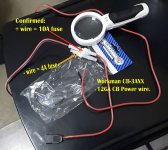wingclip
CREEPER
Hi Folks,
I have a Stryker SR955HPC (V2) radio that's been converted to 11 meter and has been Peaked & Tuned. I don't have a 'kicker' (I don't know if they say that anymore but when I was an OTR/48 driver, that meant a power amp to boost the output), and I don't intend to get one.
Right now, the SR955 transmits about 20 to 25 miles w/o skip. I've checked the transmit power with 3 different meters and they all say the PEP is about 70W to 80W. However, I can see when I transmit, the voltage drops from the 14.4V (not transmitting), to 13.3v-13.4v!
I have it installed in a 2022 Jeep Grand Cherokee WK and at this time. I plan to change the present power lines to a 12-gauge wire and run it directly to the Jeep's battery, (which is under the front passenger seat). The radio is presently powered by a 16-Gauge 3-pin wire, plugged into a cigarette lighter port. The 16-Gauge power wire has a single15 Amp bus fuse in-line on the positive side.
It took quite a lot of searching before I found a 3-Pin power cable in the 12-Gauge size. I found this one, (linked): "3 pin POWER CORD Extra HEAVY Duty 12 Ga for CB / Ham radios - Workman CB3AXX". The Workman CB3AXX has 2 inline fuses. The positive line has a 10-amp fuse and the negative line has a 4-amp fuse.
OK, so because it was hard to find any 12-gauge, 3-pin, power wires for CBs, I began wondering if there was a reason for that. It seems to me that the heavier gauge wire would be a step up from the 16 gauge, but am I missing something? Should I avoid the 12-gauge wire for a direct connection?
Also, the Workman's CBAXX has a fuse in each line, but neither is 15 amps. I thought I should maybe replace the 10-amp fuse in the positive line of the CBAXX for a 20-amp fuse. Would that be a generally good idea?
And what about the 4-amp fuse they supply in the negative line? I didn't plan to change that fuse, but then, I'm not so sure what I should do with it. Does anyone think I should remove or change the 4-amp to something else?
My thanks to anyone who may help me decide.
Rich
I have a Stryker SR955HPC (V2) radio that's been converted to 11 meter and has been Peaked & Tuned. I don't have a 'kicker' (I don't know if they say that anymore but when I was an OTR/48 driver, that meant a power amp to boost the output), and I don't intend to get one.
Right now, the SR955 transmits about 20 to 25 miles w/o skip. I've checked the transmit power with 3 different meters and they all say the PEP is about 70W to 80W. However, I can see when I transmit, the voltage drops from the 14.4V (not transmitting), to 13.3v-13.4v!
I have it installed in a 2022 Jeep Grand Cherokee WK and at this time. I plan to change the present power lines to a 12-gauge wire and run it directly to the Jeep's battery, (which is under the front passenger seat). The radio is presently powered by a 16-Gauge 3-pin wire, plugged into a cigarette lighter port. The 16-Gauge power wire has a single15 Amp bus fuse in-line on the positive side.
It took quite a lot of searching before I found a 3-Pin power cable in the 12-Gauge size. I found this one, (linked): "3 pin POWER CORD Extra HEAVY Duty 12 Ga for CB / Ham radios - Workman CB3AXX". The Workman CB3AXX has 2 inline fuses. The positive line has a 10-amp fuse and the negative line has a 4-amp fuse.
OK, so because it was hard to find any 12-gauge, 3-pin, power wires for CBs, I began wondering if there was a reason for that. It seems to me that the heavier gauge wire would be a step up from the 16 gauge, but am I missing something? Should I avoid the 12-gauge wire for a direct connection?
Also, the Workman's CBAXX has a fuse in each line, but neither is 15 amps. I thought I should maybe replace the 10-amp fuse in the positive line of the CBAXX for a 20-amp fuse. Would that be a generally good idea?
And what about the 4-amp fuse they supply in the negative line? I didn't plan to change that fuse, but then, I'm not so sure what I should do with it. Does anyone think I should remove or change the 4-amp to something else?
My thanks to anyone who may help me decide.
Rich


